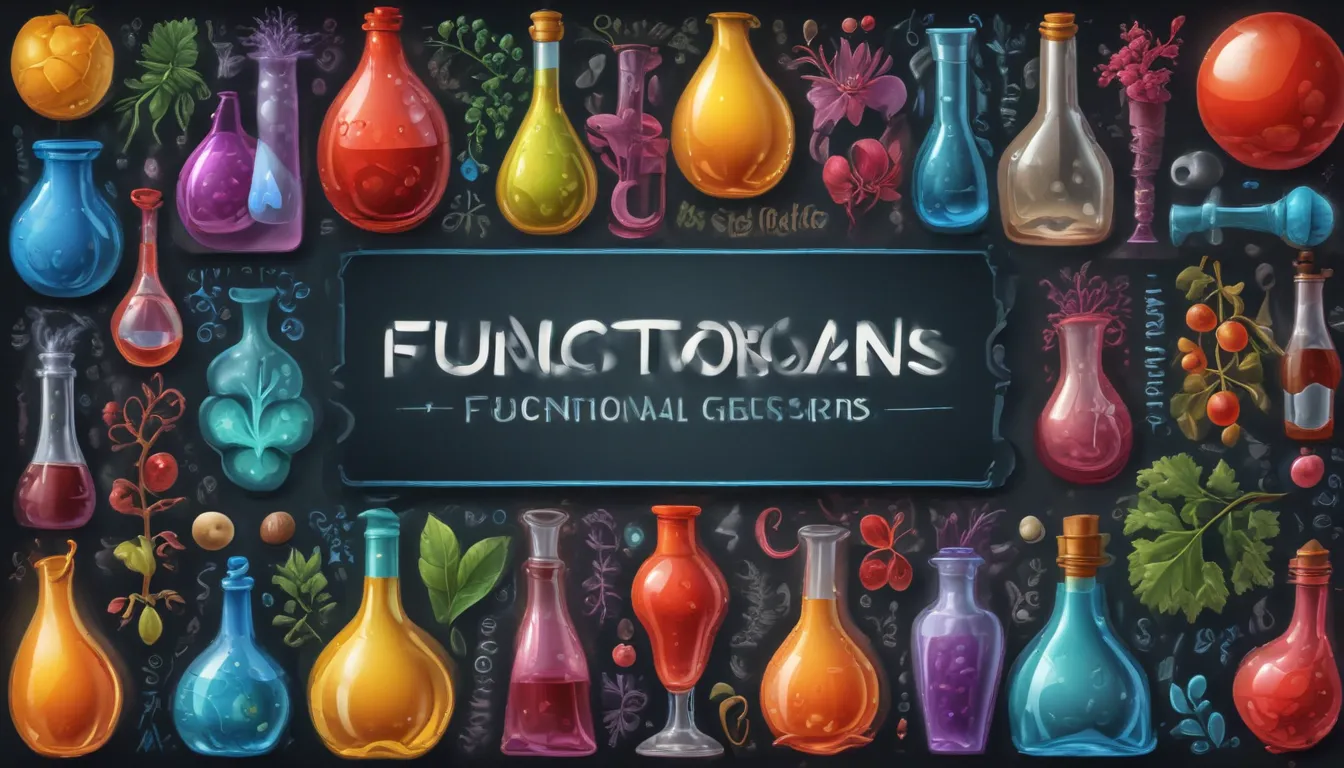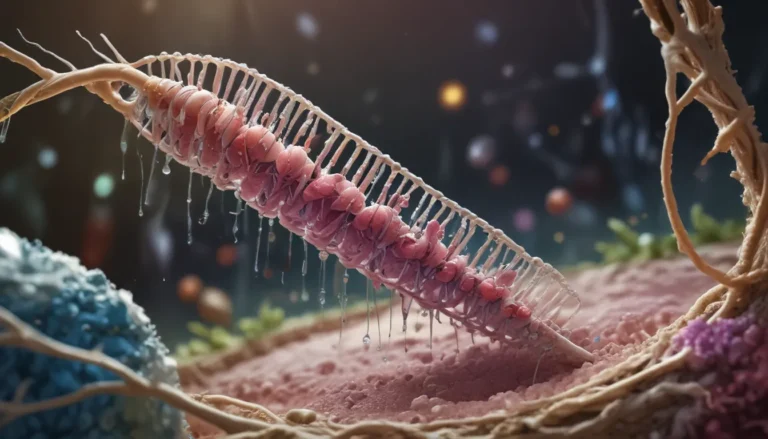A Note About Images: The images used in our articles are for illustration purposes only and may not exactly match the content. They are meant to engage readers, but the text should be relied upon for accurate information.
Have you ever wondered about the tiny yet mighty components that shape the behavior and reactivity of organic compounds? Functional groups, the unsung heroes of organic chemistry, hold the key to unlocking a world of fascinating facts and diverse applications. In this article, we will delve into 12 surprising facts about functional groups that will broaden your understanding of organic chemistry and showcase their profound impact on the world of science. So, buckle up and prepare to be amazed by the intricate nature of functional groups!
Functional Groups: The Powerhouses of Organic Compounds
Functional groups are like the superheroes of organic compounds, determining their behavior and reactivity. These specific arrangements of atoms can transform molecules, influence properties, and even help chemists identify specific compounds in a sample. By understanding functional groups, scientists can predict how organic compounds will behave and create new molecules with unique properties. These groups are the secret codes that unlock the mysteries of organic chemistry!
Unraveling the Role of Functional Groups
Functional groups are the reactive centers of organic compounds, with specific combinations of atoms dictating their chemical behavior and reactivity. From simple structures like hydroxyl (-OH) to complex arrangements like amino (-NH2), these groups play a crucial role in shaping the properties of organic molecules.
The Impact of Functional Groups in Organic Synthesis
Functional groups serve as the focal points for organic synthesis, allowing chemists to modify and transform molecules to create new compounds with different properties. By harnessing the power of functional groups, organic chemists can craft a diverse array of molecules through chemical reactions.
Unique Properties Imparted by Functional Groups
The presence of specific functional groups can significantly influence the physical and chemical properties of organic compounds. For example, the hydroxyl group imparts the characteristic properties of alcohols, such as solubility in water and the ability to form hydrogen bonds.
The Diversity of Isomers with Different Functional Groups
Isomers with different functional groups exhibit distinct chemical reactivities and biological activities, showcasing the significant role of functional groups in determining compound behavior. These variations in structure highlight the versatility and impact of functional groups in organic chemistry.
Delving into Functional Group Transformations
Functional group transformations involve the conversion of one functional group into another through specific chemical reactions. These transformations are valuable tools in organic synthesis, allowing chemists to interconvert functional groups and create a wide array of compounds with unique properties.
The Influence of Functional Groups on Intermolecular Interactions
Functional groups play a crucial role in intermolecular interactions, such as hydrogen bonding, Van der Waals forces, and dipole-dipole interactions. These interactions greatly affect the physical properties and behavior of organic compounds in diverse environments.
Functional Groups as Indicators in Chemical Analysis
Due to their unique chemical reactivity, functional groups can serve as indicators for specific compounds or chemical reactions. By identifying the presence or absence of certain functional groups, chemists can analyze the composition of a sample or monitor the progress of a reaction.
Enhancing Biological Activity through Functional Group Modifications
The addition or alteration of functional groups in organic compounds can significantly impact their biological activity. Medicinal chemists often utilize functional group modifications to optimize the potency, selectivity, and safety profiles of drugs, showcasing the pivotal role of functional groups in drug discovery.
Understanding Acidity and Basicity through Functional Groups
Certain functional groups, such as carboxylic acids and amines, can influence the acidity or basicity of organic compounds, leading to the formation of acidic or basic reactions. These groups play a vital role in determining the behavior of compounds in different chemical environments.
Exploring the Diversity of Functional Group Families
Functional groups are classified into different families based on their structural characteristics and chemical behavior. Common families include alcohol, aldehyde, ketone, amine, carboxylic acid, and ester groups, each with its distinct properties and reactivities.
The Versatility of Functional Group Reactions
Functional groups can undergo addition or elimination reactions, enabling the formation of complex organic structures. These reactions are essential in organic chemistry, allowing chemists to create a diverse array of compounds with varying properties and functionalities.
Unveiling the Fascinating World of Functional Groups
Functional groups are a fundamental concept in organic chemistry, providing a systematic way to categorize and analyze the behavior of organic compounds. By understanding the characteristics and interactions of functional groups, scientists can predict reactions and study the properties of diverse organic molecules.
Conclusion: Embracing the Intricacies of Functional Groups
Functional groups are integral components of organic chemistry, influencing the properties and reactivity of molecules in profound ways. From alcohol and carbonyl groups to amino and nitro groups, the vast array of functional groups showcases the beauty and complexity of organic chemistry. By diving deep into the world of functional groups, chemists can unravel the mysteries of organic compounds and harness their potential in fields like drug discovery, material science, and environmental chemistry.
FAQs: Your Path to Deeper Understanding
-
What is a functional group?
A functional group is a specific group of atoms within a molecule that determines its characteristic properties and reactivity. -
How do functional groups affect the properties of organic compounds?
Functional groups can alter the physical and chemical properties of organic compounds, including boiling points, solubility, acidity, and reactivity. -
Are functional groups only found in organic compounds?
Functional groups are predominantly found in organic compounds but can also exist in inorganic compounds. -
What are some common functional groups?
Common functional groups include hydroxyl (OH), carbonyl (C=O), amino (NH2), carboxyl (COOH), and methyl (CH3) groups. -
How are functional groups used in drug discovery?
Functional groups play a crucial role in drug discovery by interacting with specific receptors or enzymes, influencing drug effectiveness and minimizing side effects. -
Can functional groups undergo chemical reactions?
Yes, functional groups can participate in various chemical reactions, such as substitution, addition, elimination, and oxidation-reduction reactions. -
How do functional groups help in identifying compounds?
Functional groups provide essential clues about the structure and identity of a compound, aiding in its identification through techniques like spectroscopy and mass spectrometry.
By exploring the surprising facts about functional groups, you embark on a journey of discovery and enlightenment in the realm of organic chemistry. Whether unraveling the mysteries of nucleophilic addition reactions or marveling at the unique properties of thiols, each aspect of functional groups offers a window into the captivating world of chemistry. So, brace yourself for a voyage of knowledge and fascination as you delve deeper into the wonders of functional groups and their impact on the chemical world.






